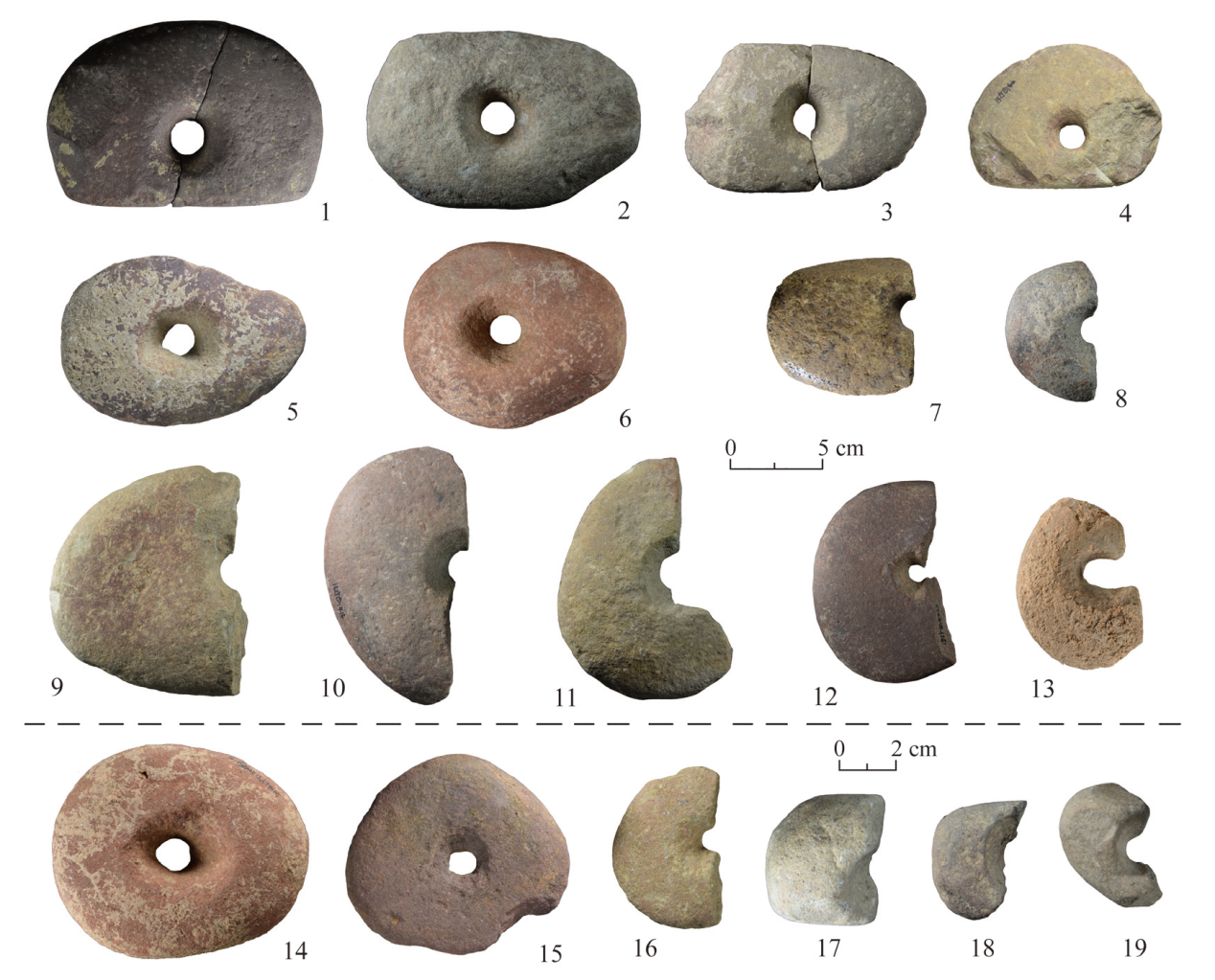

广西隆安娅怀洞遗址出土的穿孔石器
收稿日期: 2024-10-18
修回日期: 2025-02-17
网络出版日期: 2025-06-18
基金资助
国家社会科学基金重大项目(22&ZD246)
Perforated stone tools from the Yahuai Cave site in Long’an, Guangxi
Received date: 2024-10-18
Revised date: 2025-02-17
Online published: 2025-06-18
穿孔石器广泛发现于中国南方及东南亚地区史前遗址中,通常和打制石器、磨制石器等遗物共存,是该地区史前文化的一个重要因素。由于各遗址发现的穿孔石器数量少,在很大程度上限制了对其深入研究的可能性,以致学界在关于其功能和用途方面存在多种不同看法。近年来,在广西娅怀洞遗址发现数量较多的穿孔石器,不仅年代早至距今约2.5万年,而且形制多样,并保留有明显的使用痕迹。本研究综合分析了广西隆安娅怀洞遗址穿孔石器的形态特征、制作技术和使用痕迹,并结合遗址背景初步揭示了它们功能的多样性。研究推测穿孔石器可能作为制绳、取火和掘土工具使用,同时可能兼作石锤、石砧和研磨器等工具。穿孔石器功能和用途的多样性不仅体现了史前先民对工具的创新使用,也反映了他们适应环境的智慧与生存策略。

谢颖 , 付琳 . 广西隆安娅怀洞遗址出土的穿孔石器[J]. 人类学学报, 2025 , 44(03) : 439 -450 . DOI: 10.16359/j.1000-3193/AAS.2025.0036
Perforated stones are widely distributed in prehistoric sites across South China and Southeast Asia. Typically coexisting with chipped stone tools, ground stone tools, and other relics, they constitute a significant element of the regional prehistoric culture. However, due to the limited number of perforated stones unearthed at each site, in-depth research opportunities are substantially restricted, leading to diverse academic viewpoints regarding their functions and usage.
In Guangxi, the perforated stones excavated date from the late Paleolithic to the late Neolithic period, indicating their long - term utilization. In recent years, a substantial quantity of perforated stones has been discovered at Yahuai Cave in Guangxi. These artifacts not only date back to as early as 25,000 years ago but also exhibit diverse shapes and distinct usage traces.
This study conducts a comprehensive analysis of the shape characteristics, raw materials, and usage traces of the perforated stones from Yahuai Cave. The size characteristics of the perforated stones and the presence or absence of a grinding surface serve as the classification criteria. Archaeological evidence at the site reveals that prehistoric inhabitants of Yahuai Cave utilized stone anvils to process these perforated stones. The raw materials of the Yahuai Cave perforated stones are predominantly flat, round, or nearly round sandstone cobbles. They were perforated through a two - face piercing method at the center of the stone body, with stone awls employed as the primary processing tool.
Most of the perforated stones display usage traces in the hole area and on parts of the stone body, and some are stained with ochre pigment. Integrating the site context, this study reveals the functional diversity of these perforated stones. It is speculated that they might have been used for plant rope making, as fire - making tools, and digging tools. Additionally, they could have served as stone hammers, stone anvils, and stone grinding tools, participating in ochre processing activities such as grinding and crushing. The extensive usage traces on various parts of the perforated stones suggest a high overall utilization rate, indicating that they were versatile utility tools.
On one hand, the functional diversity of perforated stones reflects the innovative tool - using practices of prehistoric people; on the other hand, it also demonstrates the wisdom and environmental adaptation strategies of prehistoric communities.

Key words: Guangxi; Yahuai Cave site; perforated stone tools; Upper Paleolithic
| [1] | 广西柳州市白莲洞洞穴科学博物馆. 柳州白莲洞[M]. 北京: 科学出版社, 2009 |
| [2] | 中国社会科学院考古研究所, 广西壮族自治区文物工作队, 桂林甑皮岩遗址博物馆, 等. 桂林甑皮岩[M]. 北京: 文物出版社, 2003 |
| [3] | 广东省文物考古研究所,北京大学考古文博学院,英德市博物馆. 广东英德市青塘遗址[J]. 考古, 2019, 7: 3-15 |
| [4] | 蒋乐平(主编), 浙江省文物考古研究所(编著). 上山文化:发现与记述[M]. 北京: 文物出版社, 2016 |
| [5] | 江西省文物管理委员会. 江西万年大源仙人洞洞穴遗址试掘[J]. 考古学报, 1963, 1: 1-16 |
| [6] | 福建省文物管理委员会. 福建福清东张新石器时代遗址发掘报告[J]. 考古, 1965, 2: 49-61 |
| [7] | 李英华, 周玉端, 郝思德, 等. 海南三亚落笔洞遗址石器工业新研究——与东南亚和平文化遗址的比较[J]. 考古, 2020, 1: 68-81 |
| [8] | 云南省文物考古研究所(编). 探寻历史足迹保护文化遗产:纪念云南省文物考古研究所成立50年[M]. 昆明: 云南教育出版社, 2009, 31-34 |
| [9] | 谢颖. 广西史前穿孔石器初探[J]. 南方文物, 2025, 1:133-142 |
| [10] | Nguyen Khac Su. Prehistoric Archaeology of Dak Lak[M]. Hanoi: Social Science Publishing House, 2004 |
| [11] | Hoang Xuan Chinh. The Hoa binh Culture in Vietnam[M]. Hanoi: Social Sciences Publishing House, 1989 |
| [12] | Nguyen Khac Su. Archaeology of the Northeast Coast of Vietnam[M]. Hanoi: Social Sciences Publishing House, 2005 |
| [13] | Imdirakphol S, Zazzo A, Auetrakulvit P, et al. The perforated stones of the Doi Pha Kan burials (Northern Thailand): A Mesolithic singularity?[J]. Comptes Rendus Palevol, 2017, 16(3): 351-361 |
| [14] | 谢光茂. 广西隆安娅怀洞遗址[J]. 大众考古, 2018, 1: 12-13 |
| [15] | 谢光茂, 林强, 余明辉, 等. 广西隆安娅怀洞遗址发掘报告[J]. 人类学学报, 2025, 44(3): 365-388 |
| [16] | 广西柳州白莲洞洞穴科学博物馆. 柳州白莲洞[M]. 北京: 科学出版社, 2009 |
| [17] | Adams JL. Ground stone analysis (2nd)[M]. Salt Lake City: University of Utah Press, 2014 |
| [18] | Tomasic JJ. Donut stones as thigh-supported spindle whorls: Evidence of ancient Maya household yarn and cordage production[J]. Latin American Antiquity, 2012, 23(2): 215-228 |
| [19] | 周国兴. 石器时代的“万能工具”:穿孔砾石或穿孔石(重石)[J]. 农业考古, 2007, 1: 127-147 |
| [20] | 邓小红. 两广地区原始穿孔石器用途考[A].见:英德市博物馆,等(编). 等(编).中石器文化及有关问题研讨会论文集[C]. 广州: 广东人民出版社, 1999, 268-274 |
| [21] | 宋艳波, 谢光茂, 赵文丫. 广西隆安娅怀洞遗址出土动物遗存初步研究[J]. 第四纪研究, 2020, 40(2): 344-346+348-353. |
| [22] | Stewart H, lndian Fishing: Early methods on the Northwest coast[M]. Seattle: University of Washington Press, 1977 |
| [23] | 英德市博物馆,中山大学人类学系,广东省文物考古研究所. 英德史前考古报告[M], 广州: 广东人民出版社, 1999 |
| [24] | Oakley KP. Man the Tool-maker[M]. London: British Museum, 1961 |
| [25] | 陈胜前. 史前的现代化——中国农业起源过程的文化生态考察[M]. 北京: 科学出版社, 2004 |
| [26] | 杨晓燕, 李昭, 王维维, 等. 稻作南传:岭南稻作农业肇始的年代及人类社会的生计模式背景[J]. 文博学刊, 2018, 33-47 |
| [27] | Yang X, Barton HJ, Wan Z, et al. Sago-Type Palms Were an Important Plant Food Prior to Rice in Southern Subtropical China[J]. PLOS ONE, 2013, 8(5): e63148 |
| [28] | Hardy BL, Moncel M-H, Kerfant C, et al. Direct evidence of Neanderthal fibre technology and its cognitive and behavioral implications[J]. Scientific Reports, 2020, 10: 4889 |
| [29] | 葛梦嘉, 孙晓, 蒋玉秋, 等. 传统制绳工艺考释[J]. 丝绸, 2021, 58(7): 99-103 |
| [30] | Watts I, Chazan M, Wilkins J. Early evidence for brilliant ritualized display: specularite use in the Northern Cape (South Africa) between similar to 500 and similar to 300 ka[J]. Current Anthropology, 2016, 57(3): 287-310 |
| [31] | Brooks AS, Yellen JE, Potts Richard, et al. Long-distance stone transport and pigment use in the earliest Middle Stone Age[J]. Science, 2018, 360(6384): 90-94 |
| [32] | 杨石霞, 许竞文, 浣发祥. 古人类对赭石的利用行为在其演化中的意义[J]. 人类学学报, 2022, 41(4): 649-658 |
| [33] | 申艳茹. 中国旧石器时代遗址中赭石的功能[J]. 南方文物, 2020, 1: 187-192 |
| [34] | 周玉端, 翟天民, 李桓. 旧石器时代人类对赭石的利用[J]. 江汉考古, 2017, 2: 43-51 |
| [35] | Wang FG, Yang SX, Ge JY, et al. Innovative ochre processing and tool use in China 40,000 years ago[J]. Nature, 2022, 603: 284-289 |
/
| 〈 |
|
〉 |